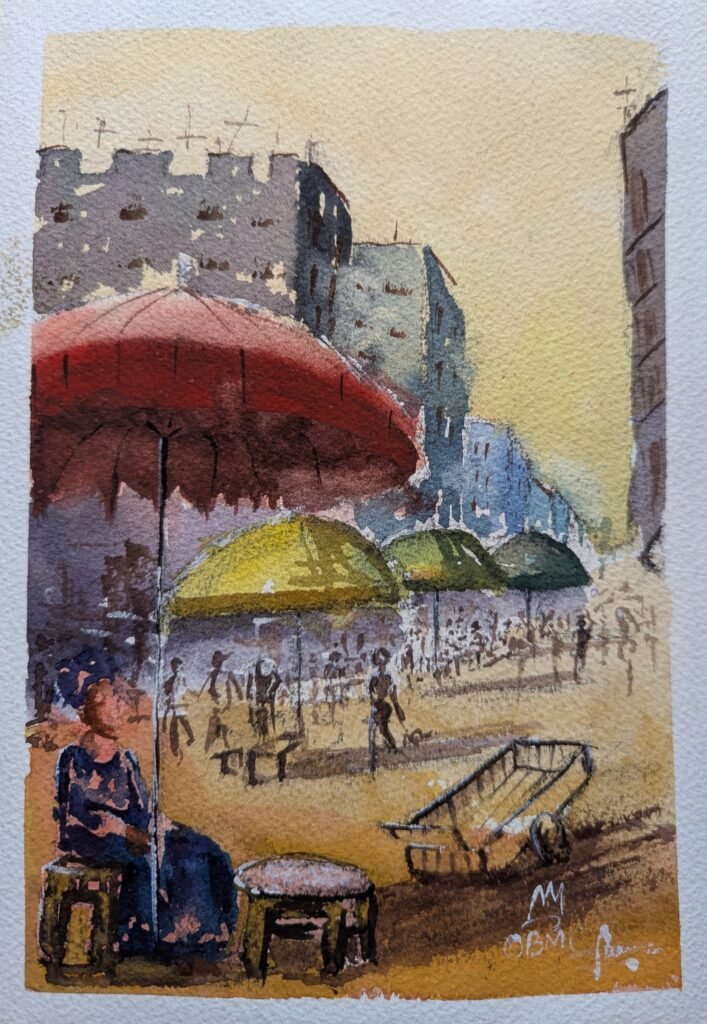
The Nigerian market is a vibrant tapestry of culture, commerce, and community, a place where the heartbeat of daily life echoes through every interaction. Market Square, a captivating watercolor painting, offers a window into this dynamic world, capturing the essence of day-to-day activities in a Nigerian market. Let’s immerse ourselves in this scene and explore the rich layers of life that define these bustling spaces, from their sensory richness to their cultural and economic significance.
Markets in Nigeria—whether in the sprawling streets of Lagos, the organized chaos of Onitsha, or smaller towns—are the lifeblood of local communities. As the sun rises, often before 6:00 AM, vendors begin their day, arriving with goods carefully sourced from farms, artisans, or wholesalers. In Market Square, the artist portrays this preparation through the seated woman in the foreground, her calm demeanor suggesting she’s ready for a long day of trade. Her small table, likely holding goods like fresh tomatoes, okra, or handmade beads, is a common sight in Nigerian markets, where vendors set up makeshift stalls under colorful umbrellas to shield themselves from the relentless sun. These umbrellas, like the red, yellow, and green ones in the painting, are more than functional—they’re symbols of resilience, offering shade in a climate where temperatures can soar past 90°F.
By mid-morning, the market is a whirlwind of activity. The painting’s background, filled with loosely sketched figures, captures the flurry of motion as shoppers weave through the crowd. Some balance baskets on their heads, a traditional practice that showcases the strength and skill of Nigerian women, while others push wheelbarrows, as seen in the artwork’s right corner. Haggling is an art form here, and the air buzzes with animated exchanges. “Aunty, this fish is N500, but I’ll give you for N400 if you buy two!” a vendor might shout, met with a playful retort: “Haba, you want to finish my money? Make it N300!” This lively banter, often laced with humor, is as much a part of the market as the goods themselves, reflecting the spirited nature of Nigerian social interactions.
The sensory experience of a Nigerian market is overwhelming in the best way. The air is thick with the aroma of street food—sizzling suya (spiced grilled meat), frying akara (bean cakes), and the sweet scent of puff-puff (fried dough balls). Vendors call out to passersby, their voices rising above the hum of the crowd: “Buy your fresh pepper here!” or “Cold pure water, N10 only!” In Market Square, the yellow and green umbrellas hint at food stalls where shoppers might pause for a quick meal, perhaps savoring a plate of jollof rice or a stick of suya, fueling up for the rest of their day. The ground, often a mix of dirt and concrete, is scattered with bits of yam peels or spilled grains, a testament to the market’s constant motion.
Markets are also social hubs, where community ties are strengthened. Friends meet under the shade of a stall to catch up, sharing stories about family or the latest town gossip. “You hear say Mama Ngozi don born twins?” one might ask, sparking laughter and congratulations. The painting captures this communal spirit—figures in the background, though indistinct, suggest a diverse crowd: young and old, men and women, all brought together by the shared necessity of trade. For many, the market is a daily ritual, especially for women who often balance childcare with commerce, their babies strapped to their backs as they sell. This multitasking is a quiet act of resilience, one that ensures their families are fed and their businesses thrive.
Economically, Nigerian markets are lifelines, especially for small-scale traders. A single day’s earnings—perhaps N5,000 on a good day—might determine whether a family eats that night or whether a child’s school fees are paid. The stakes are high, and vendors work tirelessly, often sourcing goods from rural farmers or creating products themselves, like the intricately woven baskets or Ankara fabrics that fill many stalls. Markets also reflect Nigeria’s economic challenges. Inflation, which has been a persistent issue in recent years, drives up the cost of goods, and vendors must adapt, sometimes selling smaller portions to keep prices affordable. A bunch of plantains that cost N1,000 last year might now be N1,500, forcing both buyers and sellers to adjust.
As the day progresses, the market’s energy shifts. By afternoon, the initial rush slows, and vendors take a moment to rest, perhaps sipping on a sachet of pure water or sharing a laugh with a neighboring seller. The painting’s warm, golden light suggests this time of day, with long shadows stretching across the square, hinting at the sun’s descent. Yet, even as evening approaches, the market doesn’t fully quiet. Night markets are common, with lanterns or small generators lighting up stalls as vendors cater to latecomers or those returning from work. The glow of these lights, though not depicted in the painting, would add another layer of warmth to the scene.
The Nigerian market is a place of resilience and ingenuity. Despite challenges like inflation, poor infrastructure, or unpredictable weather, vendors adapt. A sudden rain might send everyone scrambling for cover, but within minutes, they’re back, tarps in place, ready to continue. This adaptability is a testament to the determination that defines Nigerian market life. Market Square beautifully encapsulates this dynamic world, inviting us to appreciate the beauty in the everyday. The painting reminds us that markets are cultural landmarks where history, tradition, and community intersect. Next time you pass a market, take a moment to soak in its sights, sounds, and smells—you’ll be stepping into a world as rich and colorful as the one captured on this canvas, a world that continues to thrive against all odds.
1 Comment
🔎 + 1.740842 BTC.GET - https://graph.org/Payout-from-Blockchaincom-06-26?hs=6f0b5996766a08c4bb6ae1c5509ef487& 🔎 · July 9, 2025 at 8:23 am
p6ympp